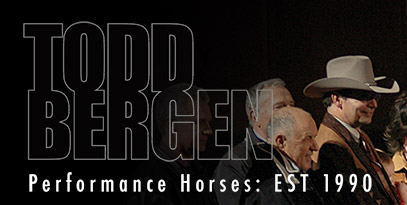Event appeal: Reining; working cow horse.
Goal: To achieve straight head-to-tail body alignment in your horse when performing a rundown/ stop maneuver.
Benefit: You'll improve your chances for correct, butt-in-the-ground sliding stops-and thus the opportunity to wow judges and score some plus-points.
Body alignment is critical to a correct stop, and the rundown is merely a wind-up to that maneuver. A crooked-bodied rundown will haunt your stop in the form of a post-legged front end, a crooked hind end (and thus tracks that resemble a peace sign, rather than a perfect 11), and other such slide-sinkers. By teaching your horse to carry himself in straight alignment, you'll not only improve your chances on the stop, but will also see improved performance on all maneuvers.
Straight alignment translates into balance, and balance is key to maximizing your horse's athletic potential.
#1 - Alignment problems will reveal themselves in two ways: Your horse will either travel straight, but with a crooked body; or will veer in one direction or the other, regardless of your "go straight" cues. In this photo, my horse is demonstrating the first category: Much like a car with a bent frame, he's traveling on a straight line but is "crabbing." His right shoulder has bulged out of alignment with his ribs and hindquarters, to the point that his right hind foot is falling in the track of his left front. You'll know your horse is crabbing when you feel his front end lean to the right-and see his withers pointing toward your destination, but his head and shoulders pointing to the right or left of it.
Advertisement
A horse that veers will be less subtle. As with a car with alignment problems, you'll feel a constant pull to one side. If you were to let go of the "steering wheel," your horse would veer off in his chosen direction. I'll give you two fixes that'll work for both of these problems.
#2 - Fix #1: The instant you feel an alignment problem, steer-hard-in the direction opposite the bulge or veer, using your outside leg at the cinch to reinforce your "get straight" cue. (For instance, in Photo 1, my horse's shoulders are bulging out to the right. To realign them with his body, I reined him to the left while simultaneously applying right-leg pressure.) You can see that I've initiated the cue, and my horse is beginning to respond. But his shoulders are still out of alignment, as evidenced by the three- hoof-track he's loping on.
#3 - A stride later, my horse's shoulders are tucked back in line. When your horse reaches this point, return your hand and leg to neutral and allow him to lope off on a straight line. Repeat this fix whenever you feel a body part drift out of place. If he's in the habit of traveling out of alignment, this could be often-until he learns to hold his body straight. (Training tip: Avoid the temptation to hold your horse on a straight line. The purpose of these exercises is to teach him, through repetition, to always move in straight alignment unless asked to do otherwise. If you were to constantly shift his body parts, you'd be masking the problem, not fixing it.)
#4 - Fix #2: If your horse is chronically crooked, and/or as an exercise to reinforce the lope-straight message, drive his hindquarters into a barrier created by bit pressure. This will automatically cause his spine to straighten, as you'll literally be guiding him into a chute created by your legs and reins. Here's how: With a rein in each hand, establish a lope. Simultaneously widen and raise your hands to just above pommel level; establish equal contact with his mouth; and use equal leg pressure to drive him into the bit. Lope the entire rundown in this manner, repeating as necessary as a correction or tuneup. You can see here how well this exercise works. My horse's head and neck are centered, and his hind legs are perfectly aligned with his front ones. He's the picture of straight body alignment. (Bonus: This drive-from-behind exercise is a great suppler, too.)
#5 - The true test comes when you begin to increase the speed on your rundowns-added rpms can cause a horse to get sloppy with his body. Stay consistent with your fixes, however, and he'll learn that more speed doesn't mean less straight. In time, he'll be consistently galloping down to a stop with his body centered between your legs and reins, as my horse is here.
#6 - The payoff? Pay dirt, in the form of a dynamic-and point-earning-sliding stop.
This article first appeared in the August, 1997 issue of Horse & Rider magazine.
|



